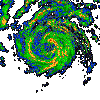 NOAA
NOAA*Information From: FAQ: Hurricanes, Typhoons, and Tropical Cyclones
Subject: A1) What is a hurricane, typhoon, or tropical cyclone?
 NOAA
NOAAThe terms "hurricane" and "typhoon" are regionally specific names for a strong "tropical cyclone". A tropical cyclone is the generic term for a non-frontal synoptic scale low-pressure system over tropical or sub-tropical waters with organized convection (i.e. thunderstorm activity) and definite cyclonic surface wind circulation (Holland 1993).
Tropical cyclones with maximum sustained surface winds of less than 17 m/s (34 kt, 39 mph) are called "tropical depressions". (This is not to be confused with the condition mid-latitude people get during a long, cold and grey winter wishing they could be closer to the equator ;-)) Once the tropical cyclone reaches winds of at least 17 m/s they are typically called a "tropical storm" and assigned a name. If winds reach 33 m/s (64 kt, 74 mph)), then they are called: a "hurricane" (the North Atlantic Ocean, the Northeast Pacific Ocean east of the dateline, or the South Pacific Ocean east of 160E); a "typhoon" (the Northwest Pacific Ocean west of the dateline); a "severe tropical cyclone" (the Southwest Pacific Ocean west of 160E or Southeast Indian Ocean east of 90E); a "severe cyclonic storm" (the North Indian Ocean); and a "tropical cyclone" (the Southwest Indian Ocean) (Neumann 1993).
Note that just the definition of "maximum
sustained surface winds" depends upon who is taking the
measurements. The World Meteorology Organization guidelines suggest utilizing a
10 min average to get a sustained measurement. Most countries utilize this as
the standard. However the National Hurricane Center (NHC) and the Joint Typhoon
Warning Center (JTWC) of the USA use a 1 min averaging period to get sustained
winds. This difference may provide complications in comparing the statistics
from one basin to another as using a smaller averaging period may slightly raise
the number of occurrences (Neumann
1993).